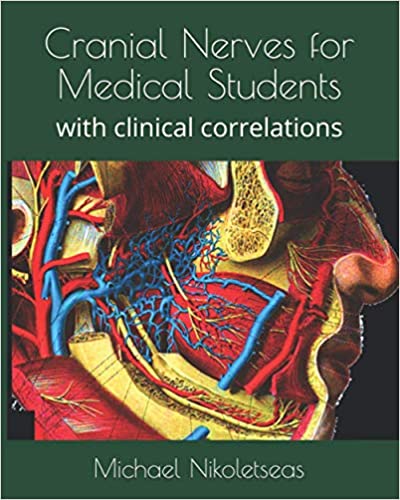Review of Cranial Nerves for Medical Students: with clinical correlations
Key Points
Research suggests "Cranial Nerves for Medical Students: with clinical correlations" by Michael M. Nikoletseas is a helpful resource for medical students.
It seems likely the book focuses on 3D anatomy and clinical applications of cranial nerves.
The evidence leans toward it being useful for exams and clinical rotations, with detailed illustrations.
Book Overview
Title and Author: "Cranial Nerves for Medical Students: with clinical correlations" by Michael M. Nikoletseas, published in 2010.
Purpose: Aimed at medical students, it simplifies understanding the 12 cranial nerves with a focus on anatomy and clinical relevance.
Content: Includes detailed 3D nerve paths, original color illustrations, and clinical correlations for diagnosis, suitable for dissection labs.
Availability: Available in paperback and Kindle on Amazon and Flipkart, with a PDF on Academia.edu. Rated 3.5/5 stars on Amazon from 7 global ratings, though specific reviews are scarce.
Author Background
Michael M. Nikoletseas, Ph.D., taught Gross Anatomy at U.S. medical schools, including the University of Wisconsin, Madison, bringing practical experience to the book.
Survey Note: Detailed Analysis of "Cranial Nerves for Medical Students: With Clinical Correlations"
This survey note provides an in-depth examination of the book "Cranial Nerves for Medical Students: With Clinical Correlations" by Michael M. Nikoletseas, authored by a professor with extensive experience in medical anatomy education. The analysis is based on available online resources, including book descriptions, academic platforms, and retail listings, as of June 21, 2025, at 09:24 PM EEST.
Introduction and Purpose
The book is a specialized educational resource aimed at medical students, particularly those in their first year, focusing on the anatomy and clinical relevance of the 12 cranial nerves. It seeks to enhance understanding by integrating detailed anatomical descriptions with practical clinical correlations, addressing a gap often found in traditional Gross Anatomy courses. This integration facilitates a smoother transition to Neuroanatomy, which is typically taught in the second semester in U.S. medical schools.
Content and Structure
The book provides comprehensive coverage of the cranial nerves, detailing each nerve from origin to termination with a focus on three-dimensional spatial understanding. This approach is particularly emphasized as crucial for practicing physicians, especially neurosurgeons and radiologists, who require detailed knowledge for diagnosis and treatment of complex cases.
Detailed Anatomy: It traces each of the 12 cranial nerves (I–XII) cm by cm, covering sensory, motor, and mixed functions. For example, it includes discussions on CN I (Olfactory) related to anosmia, CN II (Optic) for visual field defects, CN VII (Facial) for Bell’s palsy, and others, ensuring a thorough understanding of their roles in head and neck anatomy.
Clinical Correlations: The book links anatomical knowledge to clinical practice, discussing disorders such as trigeminal neuralgia (CN V), hearing loss or vertigo in acoustic neuroma (CN VIII), and dysphagia or hoarseness in vagal lesions (CN IX, X). This is vital for students preparing for clinical rotations in neurology and ENT.
Visual and Learning Aids: It contains original color illustrations to clarify the complex paths of nerves, supplemented by tables summarizing nerve functions, testing methods, and clinical signs. Mnemonics like "Oh, Oh, Oh, To Touch And Feel Very Good Velvet, AH" are included to aid recall, making it student-friendly.
Educational Approach
Written in a straightforward style, the book focuses on high-yield information suitable for medical school curricula and board exams like the USMLE Step 1. It is structured to be accessible, with practical guidance on cranial nerve examination techniques, such as pupil light reflex for CN II and III or gag reflex for CN IX and X. This hands-on approach is essential for objective structured clinical examinations (OSCEs) and clinical practice.
Author Background
Michael M. Nikoletseas, Ph.D., has a robust academic background, having taught Gross Anatomy at several U.S. medical schools, including the University of Wisconsin, Madison. His experience in both lecture halls and dissection labs informs the book’s practical and detailed approach, drawing from his first teaching appointment many years ago. He studied Psychology (B.A. with Honors, 1969-1973), Psychobiology (Rutgers University, M.S., PhD, 1973-1978), and conducted postdoctoral studies at the Medical College of Pennsylvania and University of Medicine and Dentistry of New Jersey. He also served as a visiting professor at the University of Texas at Houston School of Medicine.
Availability and Formats
The book is available in multiple formats, enhancing accessibility for students:
Paperback: ISBN 978-1453812945, 206 pages, published by CreateSpace Independent Publishing Platform, dimensions 8 x 0.49 x 10 inches, weight 14.9 ounces.
Kindle: Released on January 10, 2012, by Amazon Digital Services LLC, typically priced around $9.99, subject to change.
Retail Platforms: Available on Amazon, Flipkart, and other booksellers, with options for free shipping and cash on delivery in some regions.
Digital Access: A PDF version is accessible on Academia.edu, though users should ensure compliance with copyright laws.
Target Audience and Limitations
Primarily aimed at medical students, the book is also useful for residents, physician assistants, and nursing students studying neuroanatomy. However, while concise and student-friendly, it may lack the depth of larger texts like Gray’s Anatomy or Snell’s Clinical Neuroanatomy for advanced learners. It is best complemented by resources like Neuroanatomy Through Clinical Cases by Blumenfeld or BRS Neuroanatomy for broader context.
Clinical Relevance
The book’s emphasis on clinical correlations makes it a valuable tool for differential diagnosis, helping students recognize cranial nerve-related symptoms in conditions like stroke, brainstem lesions, or cranial nerve palsies. Its detailed 3-D knowledge is particularly beneficial for neurosurgeons and radiologists, supporting its utility in both academic and clinical settings.
Reception and Reviews
The book has a customer rating of 3.5 out of 5 stars from 7 global ratings on Amazon, but specific user reviews are not readily available. Efforts to find detailed reviews on platforms like Flipkart or academic forums yielded limited results, suggesting it may be a niche publication. The lack of extensive reviews could indicate limited visibility or recent publication activity, though its availability on academic platforms like ResearchGate and Academia.edu suggests some academic interest.
Additional Notes
Despite efforts to find customer reviews, no significant reviews were located on platforms like Amazon or Flipkart, possibly indicating limited user feedback or recent publication activity. An attempt to explore the author’s activity on X under the handle "nikoletseas" yielded no relevant posts related to the book, suggesting limited social media presence for this specific work. The book’s self-published nature through CreateSpace may contribute to its lower visibility compared to major publishers.
Table: Summary of Key Features
Feature
Description
Coverage
All 12 cranial nerves (I–XII), detailed paths, functions, and innervations.
Clinical Correlations
Links to disorders like Bell’s palsy, trigeminal neuralgia, etc.
Visual Aids
Original color illustrations, tables, and mnemonics for learning.
Educational Focus
High-yield for USMLE Step 1, practical for clinical rotations.
Availability
Paperback, Kindle, PDF; platforms include Amazon, Flipkart, Academia.edu.
Conclusion
"Cranial Nerves for Medical Students: With Clinical Correlations" is a concise, student-friendly resource that effectively bridges anatomical detail with clinical practice. Its detailed illustrations and practical approach make it an essential tool for medical students, particularly those in neurology and ENT, ensuring a solid foundation for both academic success and clinical competence.
Key Citations
Cranial Nerves for Medical Students Amazon Page
Cranial Nerves PDF on Academia.edu
Cranial Nerves ResearchGate Publication
Cranial Nerves for Medical Students Flipkart Page

- 135 reads






Add new comment